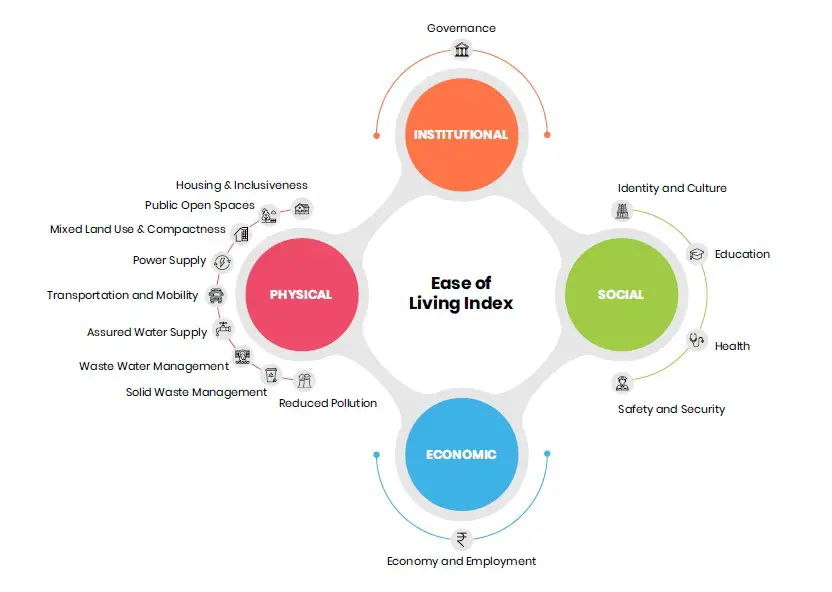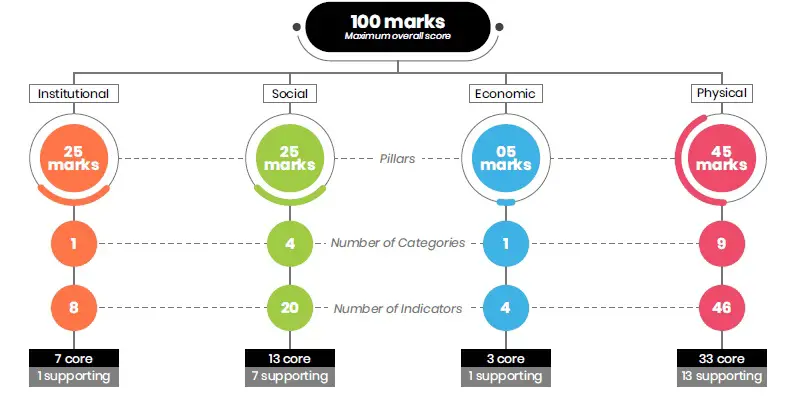According to UN department of Economic and Social affairs (2018) By 2050 India is projected to add 416 million urban dwellers to the world’s urban population and will be home to about 58% of the total global population. In the current planning practice, we as a global citizen can know the status quo of the living condition of any place all over the country through the benchmark of the living standards set by the government. These standard benchmark can be adapted as the Indicators. These Indicators guide us towards the service level benchmarks and that gives us the complete picture and an overall profile of any particular city or a region of the country.
One of these indicators which have drawn attention is Ease of living index. The ease of living index is the effort that assesses the living standards of the of the Indian cities. Ministry of Housing & Urban affairs launched the framework in 2017 that covers the 111 cities inhabited by approximately 134 million people. The Index is served as effective and efficient to help assess the progress made in the urban cities through various initiatives that keep monitors the performances of the cities. The selected 111 cities include the Smart cities, capital cities and few more with a population over a million. Another salient feature of the framework is that its linked with the sustainable development goals(SDGs) which becomes the key highlight of the framework.
Related Articles:
- Human Development Index (HDI), GDI & GEM
- Urban Governance in India: Emerging Challenges and New Approaches
- Millennium Development Goals
- Liberalization, Privatization, Globalization (LPG Model) in India
- Human Poverty Index (HPI) & Its use
The framework of the ease of living index consisting over the four major pillars of any urban development that is Physical, Social, Institutional and economical. Also, it has used the seventy-eight indicators that further divided in fifteen categories like Governance, Identity and Culture, Education, Health, Safety and Security, Economy and Employment, Housing and Inclusiveness, Public open spaces, Mixed Land use and Compactness, Power supply, Transportation and mobility, Assured water supply, Waster water management, Solid waste management and Reduced pollution. Along with that, the ease of living Index also assists cities in undertaking 360-degree assessment of their strength, weakness, opportunity and threats.

Key objectives of the EOL Index
- Generate information to guide evidence-based policy making;
- Catalyse action to achieve broader developmental outcomes including the SDG;
- Assess and compare the outcomes achieved from various urban policies and schemes; and
- Obtain the perception of citizens about their view of the services provided by the city administration.
Among the total seventy-eight indicators across the fifteen categories, Fifty six are considered as core indicator whereas twenty-two are the supporting indicators. The core indicators measure those aspects which are considered “essential” urban services while the supporting indicators are used to measure adoption of innovative practices which are considered desirable for enhancing ease of living.
Key steps involved in the implementation of the framework.
- Indicator development and refinement
- State and city level engagement
- Data collection
- Data verification
- Scoring and Ranking of the cities
Each city is given a score ranging from 0 to 100. The Dimensional Index Methodology is used to develop the index. The scores for each indication are calculated using the absolute benchmarks which are derived from national or international standards. The city with the best performance in its group (relevant population range) is used as a benchmark, and the marks given to other cities (within the relevant population group) are proportionately determined. The score that a city receives is based on its performance on each indicator under that pillar, and the level of importance i.e., the weight assigned to each pillar and indicator.
Related Articles:
- How ‘Smart’ is India’s Smart City Mission?
- Pradan Mantri Awas Yojna (PMAY) Urban
- Important Concepts in Urban Renewal – JNNURM
- Mahatma Gandhi National Rural Employment Guarantee Act
- AMRUT Mission by MoUD, Govt. of India
- Smart city concept by MoUD, Government of India
The pillar weights are as follows:
- 25 points allotted for Institutional, 25 points for Social, Economy and Employment having an allotment of five points, and 45 points to Physical.
- A core indicator carries 70% weightage while a supporting indicator carries 30% weightage. For more information on the index methodology, please refer to the Methodology for Collection and Computation of Ease of Living Standards published on gov.in.

The top cities on the Ease of Living Index have a diverse population representation. Three cities with populations under 0.5 million, four cities with populations between 0.5 and 1 million, ten cities with populations between 1 and 4 million, and three cities with populations exceeding 4 million make up the top 20 cities. This mixed representation is also true at the pillar level.
Apart from being a tool for comparative benchmarking and assessment, the Ease of Living Index could potentially trigger actions at various levels, some of which are outlined below:
- Enhance the quality and comparability of data collection;
- Improve cities’ decision making and ensure efficient allocation of resources based on gap areas;
- Identify best models for achieving the desired transformation in ease of living, by enabling learning across cities over time; and
- Improve the quality of electoral discourse and improve accountability of elected representatives at the city level.
Minister of states Mr. Hardeepsingp Puri announced the ranking list for the Ease of Living Index. The rankings under Ease of Living Index 2020 were announced for cities with a population of more than a million, and cities with less than a million people. 111 cities participated in the assessment exercise that was conducted in 2020. The analysis categorises them into Million+ populated cities (those with a population of more than a million) and Less than Million populated cites (those with a population of less than a million) along with all the cities under the Smart Cities Program.
In the category of Million plus populated cities, Bengaluru emerged as the top performer in followed by Pune, Ahmedabad, Chennai, Surat, Navi Mumbai, Coimbatore, Vadodara, Indore, and Greater Mumbai. In the Less than Million populated cities, Shimla was ranked the highest in ease of living, followed by Bhubaneshwar, Silvassa, Kakinada, Salem, Vellore, Gandhinagar, Gurugram, Davangere, and Tiruchirappalli.
Related Articles:
- Gross National Product
- Gross Domestic Product (GDP)
- Gross National Happiness (GNH) Index and its criticism
- Informal Sector in India
Author Bio: Kunal Gadhavi (Urban Planner| Architect). I am an architect Planner by profession and a Part-time writer. My writing spectrum varies from Urban Planning-Architecture to Poetry and Jingles. I am a pleasant and attentive individual with a commitment to excellence and excellent multi-tasking.
References: